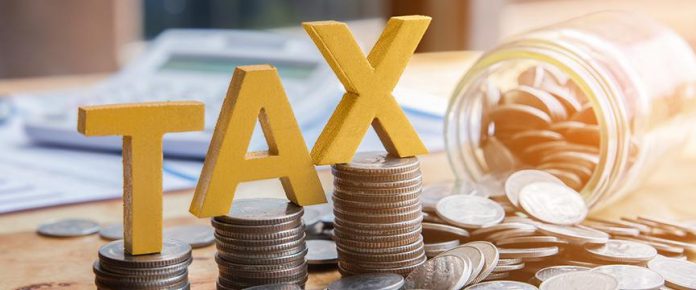This article has been written by Utkarsh Sinha pursuing Diploma in Legal English Communication – oratory, writing, listening and accuracy at LawSikho, and has been edited by Shashwat Kaushik.
It has been published by Rachit Garg.
Table of Contents
What is GST
The Central Goods and Services Act was enforced on July 1, 2017. It is a tax levied on the supply of goods and services. GST absorbed central taxes (customs, excise, central sales tax, and services tax) as CGST and state taxes (VAT, purchase tax, entertainment tax, entry tax, and Octroi) as SGST/ UTGST, and the share of both Central and state governments (CST, CVD, and SAD) as IGST. It is an indirect tax that has replaced many indirect taxes in India. This is a single domestic indirect tax law for the entire country.
Turnover limit for GST registration
On supply of goods
| Mizoram, Nagaland, Tripura and Manipur | Rs. 10 Lakhs |
| Uttarakhand, Meghalaya, Sikkim, and Arunachal Pradesh | Rs. 20 Lakhs |
| Himachal Pradesh and Assam | Rs. 40 Lakhs |
| Telangana and Puducherry | Rs. 20 Lakhs |
| All other states | Rs. 40 Lakhs |
On supply of services
| Mizoram, Nagaland, Tripura and Manipur | Rs. 10 Lakhs |
| Uttarakhand, Meghalaya, Sikkim, Arunachal Pradesh, Himachal Pradesh and Assam | Rs. 20 Lakhs |
| All other states | Rs. 20 Lakhs |
What is the Composition Scheme of GST
Every small business cannot afford to follow all GST compliance requirements, which include monthly returns, monthly payment of GST, maintaining complex records each month, and approximately 37 annual returns. In order to provide relief to small taxpayers, on April 1, 2019, the 2019 Composition Scheme under GST was introduced, wherein complying with the process of tax filing is not only less hectic but also allows them to pay GST at a comparatively lower and fixed rate.
How to file a Composition Scheme return
Under the Composition Scheme of the Goods and Services Tax (GST), a registered dealer needs to file a simplified quarterly return known as Form CMP 08. The deadline to file this return is the 18th of the month following the end of the quarter (i.e., the 18th of July, the 18th of October, the 18th of January, and the 18th of April). Additionally, an annual return called Form GSTR-9A must be filed by the 31st of December of the following financial year.
To comply with GST regulations, a dealer who has opted for the composition scheme is not obligated to keep extensive records for the purpose of filing returns.
Difference between regular scheme and composition scheme
| Regular scheme | Composition scheme |
| Monthly payment of tax | Quarterly payment of tax |
| More records to maintain | Less records to maintain |
| The input tax credit is available | The input tax credit is not available |
| This scheme is beneficial for large scale business houses as it gives them flexibility to operate businesses interstate. | This scheme is beneficial for small scale business houses, as they operate businesses in the local area. |
Eligibility for composition scheme
To be eligible for the composition scheme of GST, a taxpayer should meet the following parameters:
- They should fall under the turnover threshold limit as prescribed by law.
- You should fall under particular type of dealer or supplier as prescribed by law
Turnover threshold limit
Normal states
Normal states include all the states, excluding special states. Businesses with a turnover threshold limit under 1.5 crore in the preceding year are subject to the eligibility criteria of composition schemes.
Special states
The following are the special states:
- Arunachal Pradesh
- Manipur
- Meghalaya
- Mizoram
- Nagaland
- Sikkim Tripura
- Uttarakhand
Businesses having a turnover threshold limit under 0.75 crore in the preceding year are subject to the eligibility criteria of composition schemes.
Types of dealers/suppliers
Manufacturers
Clause 72, Section 2, of The Central Goods and Services Tax Act, 2017 defines “manufacture” as “the processing of raw materials or inputs in any manner that results in the emergence of a new product having a distinct name, character, and use,” and the term “manufacturer” shall be construed accordingly. So, a manufacturer is one who manufactures.
The Oxford dictionary defines manufacturer as “a person or company that produces goods in large quantities.”
Manufacturers can avail themselves of the benefits of the Composition Scheme of GST if their turnover is less than 1.5 crore in the case of normal states and 0.75 crore in the case of special states, and the rate of tax is 0.5% CGST and 0.5% SGST for a total of 1% GST.
Traders
The word “trader” is not defined under the Central Goods and Services Tax Act, 2017, but according to the Oxford Dictionary, a trader can be defined as “a person who buys and sells things as a job.”
Traders can avail themselves of the benefits of the Composition Scheme of GST if their turnover is less than 1.5 crore in the case of normal states and 0.75 crore in the case of special states, and the rate of tax is 0.5% CGST and 0.5% SGST for a total of 1% GST.
Restaurant services

Restaurant owners can also avail themselves of the benefits of the Composition Scheme of GST if their turnover is less than 1.5 crore in the case of normal states and 0.75 crore in the case of special states, and the rate of tax is 2.5% CGST and 2.5% SGST for a total of 5% GST.
Other services
During the 32nd GST Council Meeting held on January 10th, 2019, the Indian Government announced that service providers would now have the option to enrol in the Composition Tax Scheme.
To be eligible for the Composition Tax Scheme, the government set a threshold turnover of Rs. 50 lakh for service providers. This means that if a service provider’s annual turnover is below Rs. 50 lakh and they are not covered under Section 10(1), they can opt for the Composition Tax Scheme and pay a fixed tax rate of 6% (3% CGST + 3% SGST)
Who cannot go for the Composition Scheme
Some businesses are not eligible to opt for the Composition Scheme regardless of their turnover or the type of dealers/suppliers they are:
- Manufacturer of ice cream, pan masala, and tobacco;
- A person making inter-state supplies;
- A casual taxable person or non-resident taxable person; and
- Businesses that supply goods through an e-commerce operator.
How to apply for the Composition Scheme
If you are already registered as a regular taxpayer under GST and want to apply for the Composition Scheme, you can follow these steps:
- Log in to the GST Portal using your registered username and password.
- Go to the ‘Services’ tab and select the ‘Registration’ option from the drop-down menu.
- Click on the ‘Application to opt for the Composition Scheme’ option.
- Fill in the required details, including your GSTIN, legal name, and the date from which you want to opt for the Composition Scheme.
- Select the appropriate reason for opting for the Composition Scheme from the drop-down menu.
- Upload the necessary documents, including a declaration form, bank account details, and other relevant documents.
- Submit the application.
Once you submit the application, it will be verified by the GST department, and if there are no issues, your registration will be converted to the Composition Scheme. You will receive an intimation in this regard, and your GST rates will be reduced accordingly.
Important points
Advantages of the Composition Scheme
These are the advantages that can help small businesses thrive and grow without the burden of complicated tax rules and high tax bills:
- Reduced compliance activities;
- Limited tax liabilities; and
- Can have more cash on hand since the Composition Scheme’s GST rates are lower than the usual rates.
Disadvantages of the Composition Scheme
Before making a decision to opt for the Composition Scheme, small businesses should consider some potential drawbacks, such as:
- Ineligibility to conduct e-commerce business;
- Inability to conduct transactions across different states;
- Inability to charge customers any tax or claim input tax credit; and
- Ineligibility to supply exempt goods.
Although the Composition Scheme has its advantages, it’s important for businesses to understand these limitations and assess whether they can work around them to make the best decision for their unique circumstances.
How to convert from Composition Scheme to regular scheme
To stop paying tax under the Composition Scheme and switch to the regular scheme, a composition taxpayer must do two things.
First, they need to fill out a form called GST CMP-04 to let the authorities know that they want to withdraw from the Composition Scheme. If they’re withdrawing because their turnover has gone above the limit, they have to submit the form within 7 days of becoming eligible to register as a regular dealer. It’s important to note that this withdrawal will apply to all of the person’s business locations registered under the same PAN.
Secondly, the person moving to the regular scheme has to provide a stock statement in GST ITC-01. This statement should include details about the stock of inputs, semi-finished or finished goods they held on the day before becoming liable to be a regular dealer. Providing this statement allows the dealer to claim the input tax credit on their stock of inputs, semi-finished or finished goods, and capital goods when they become a regular dealer. They have to submit this form within 30 days of filing GST CMP-04.
Conclusion
Based on the advantages and disadvantages of the Composition Scheme, I can provide some general guidance on who may be advised to opt for it:
Businesses with a turnover of up to Rs. 1.5 crore that operate within a single state may find the Composition Scheme beneficial. It can simplify their tax compliance requirements and help them manage their cash flow more effectively. However, businesses that operate across multiple states face restrictions.
It’s important to keep in mind the potential disadvantages of the Composition Scheme, such as limitations on inter-state transactions and the inability to claim the input tax credit. Businesses that can work around these limitations and still benefit from the scheme may be advised to opt for it.
References
- https://help.tallysolutions.com/docs/te9rel61/Tax_India/gst/composition_scheme_under_gst.htm#:~:text=Under%20composition%20scheme%2C%20you%20cannot%20take%20input%20credit%20on%20your,In%20Tally
- https://www.youtube.com/watch?v=Bc_yyj5NvKk&list=PLCsNF2CyyySPXmcAlN5m2fs0PmCb4YnL3&ab_channel=CAMitra24
- https://youtu.be/_hNx6Z_gg2I
- https://cleartax.in/s/gst-composition-scheme’
- https://www.bajajfinserv.in/insights/gst-composition-scheme
Students of Lawsikho courses regularly produce writing assignments and work on practical exercises as a part of their coursework and develop themselves in real-life practical skills.
LawSikho has created a telegram group for exchanging legal knowledge, referrals, and various opportunities. You can click on this link and join:
Follow us on Instagram and subscribe to our YouTube channel for more amazing legal content.
 Serato DJ Crack 2025Serato DJ PRO Crack
Serato DJ Crack 2025Serato DJ PRO Crack










 Allow notifications
Allow notifications



